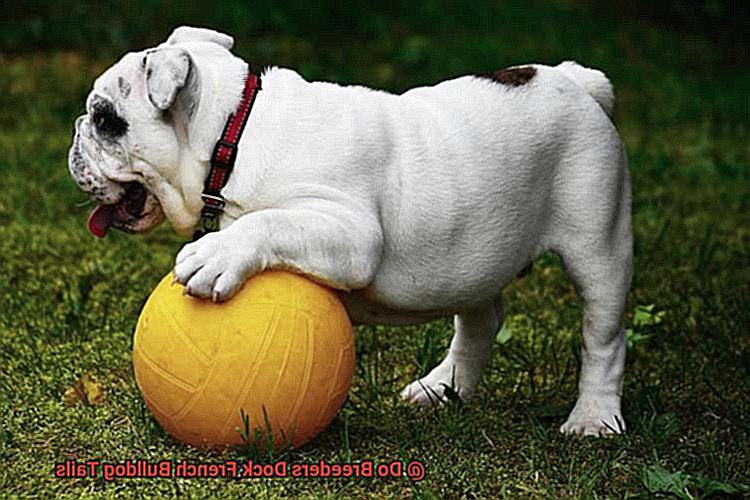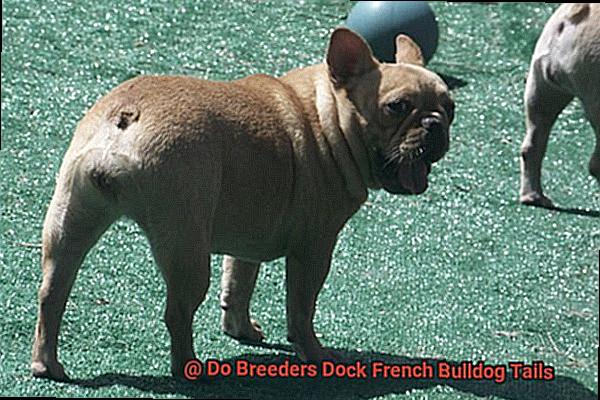Do Breeders Dock French Bulldog Tails?
Welcome, curious readers, to a topic that has ignited fiery debates among canine enthusiasts – the practice of tail docking in French Bulldogs. These adorable bat-eared companions have captured our hearts with their charming personalities and unique appearance. But here’s the burning question: do breeders snip their tails?
In this blog post, we embark on a journey through the controversial world of French Bulldog tail docking, shedding light on fascinating facts and considerations along the way. Are these lovable pups born with docked tails, or is it a contentious choice made by breeders? Let’s uncover the truth behind this hot-button issue.
Join us as we explore the ethical implications, delve into historical background, and address potential welfare concerns associated with tail docking. We’ll unravel the reasons behind this practice and examine its legality in different regions. Furthermore, we’ll dive into the viewpoints held by breeders and animal welfare organizations alike.
Whether you’re an ardent French Bulldog enthusiast, a fellow dog lover seeking knowledge, or simply intrigued by all things canine care-related, this blog post aims to provide you with a comprehensive overview of an often misunderstood topic. So grab your favorite cuppa, settle into your comfiest chair, and let’s embark on this captivating journey through the realm of French Bulldog tail docking together.
History of Tail Docking in Dogs
Contents
- 1 History of Tail Docking in Dogs
- 2 Ethical and Necessary Debate Around Tail Docking
- 3 Countries and Organizations Banning Tail Docking
- 4 American Kennel Club’s Revised Policies on French Bulldog Tails
- 5 Why French Bulldog Breeders Don’t Dock Tails
- 6 Potential Risks of Tail Docking for French Bulldogs
- 7 What to Look For When Choosing a Responsible Breeder
- 8 Conclusion
In this blog post, we will delve into the fascinating history of tail docking in dogs, with a particular focus on French Bulldogs. We will explore the origins of this practice, its prevalence over time, and the changing attitudes towards tail docking in recent years.
The Origins of Tail Docking:
Tail docking can be traced back to ancient Rome, where it was believed to enhance the agility and prevent injuries in working dogs. During the Middle Ages, tail docking became more widespread, serving purposes such as identifying working dogs and preventing injuries during hunting or fighting. It also became a status symbol for certain breeds.
Prevalence in Working Dogs:
Tail docking continued into the 19th and early 20th centuries, especially among working dog breeds and those used for fighting or protection. These dogs were often subjected to tail docking to minimize the risk of tail injuries during intense physical tasks. However, as society’s perspective on animal welfare evolved, tail docking faced criticism from animal rights activists and organizations.
Global Regulations and Opposition:
In response to growing concerns about animal welfare, many countries, including several European nations and Australia, implemented strict regulations or outright bans on tail docking in the late 20th century. The American Veterinary Medical Association (AVMA) also opposes routine tail docking unless medically necessary.
Tail Docking in French Bulldogs:
French Bulldogs are a breed known for their distinctive appearance, including their short, stubby tails. Historically, tail docking was common among French Bulldogs and many other breeds. However, in recent years, attitudes have shifted. The American Kennel Club (AKC) revised its policies on tail docking, stating that French Bulldogs should naturally have short tails. Reputable breeders now prioritize the health and well-being of their dogs and do not dock their puppies’ tails.
Choosing Responsible Breeders:
It is crucial for potential French Bulldog owners to discuss the issue of tail docking with breeders before acquiring a puppy. Reputable breeders who follow ethical practices and prioritize the welfare of their dogs will typically not dock their French Bulldogs’ tails. By choosing responsible breeders, we can contribute to the positive change in attitudes towards cosmetic procedures on animals.
Ethical and Necessary Debate Around Tail Docking
Tail docking, the surgical removal of a dog’s tail, has been a topic of ethical and necessary debate among breeders, veterinarians, and animal welfare organizations. This article aims to explore both sides of the argument surrounding tail docking specifically for French Bulldogs, highlighting the reasons behind proponents and opponents’ views.
Proponents’ Arguments:
Preventing Tail Injuries: French Bulldogs have short and screw-shaped tails, making them more susceptible to trauma and discomfort. Proponents argue that docking their tails at a young age can prevent future problems such as broken or damaged tails.
Opponents’ Arguments:
Unnecessary and Painful Procedure: Opponents believe that tail docking is an unnecessary and painful procedure that causes harm to dogs. They argue that breeders should focus on breeding for healthier and structurally sound dogs to reduce the need for tail docking.
Ethical Considerations:
Cosmetic Reasons: Some argue that it is unethical to remove a part of a dog’s body solely for cosmetic reasons. They believe that dogs should be allowed to keep their natural appearance unless there is a compelling medical reason to intervene.
Legal Status:
Banning or Restricting Tail Docking: Many countries have banned or restricted tail docking unless there is a valid medical reason. However, in some countries like the United States, it remains a common practice among certain breeds.
Alternative Options:
Regular Monitoring and Preventive Measures: Instead of tail docking, alternative options include regularly monitoring the dog’s tail for signs of injury or discomfort and taking preventive measures such as using protective garments or ensuring safe environments.

Making an Informed Decision:
Consult with a Veterinarian: Owners of French Bulldogs should consult with a veterinarian who has experience with the breed to gain valuable insights and guidance before making a decision about tail docking.
Countries and Organizations Banning Tail Docking
Tail docking, the removal of a portion of a dog’s tail, has been a contentious topic. However, many countries and organizations have come forward to ban or restrict this practice, including in beloved breeds like French Bulldogs. In this blog post, we will explore the reasons behind this movement and shed light on the various countries and organizations leading the charge against tail docking.
Legislation and Regulations:
Europe:
- England, Scotland, Wales, and Ireland have banned tail docking, except for specific working dog breeds under certain circumstances.
- Germany, Sweden, Norway, and Finland have implemented strict regulations against tail docking.
- The European Convention for the Protection of Pet Animals explicitly prohibits tail docking.

Outside of Europe:
- Australia, New Zealand, and parts of Canada have banned or restricted tail docking.
Diverse Organizations Speaking Out:
American Veterinary Medical Association (AVMA):
- Opposes routine tail docking and encourages education on alternatives.
Royal Society for the Prevention of Cruelty to Animals (RSPCA):
- Strongly opposes tail docking unless medically necessary.
Kennel Clubs and Breed Associations:
- American Kennel Club (AKC) and United Kennel Club (UKC) have revised breed standards to discourage or prohibit tail docking in show dogs.
Why the Movement is Gaining Momentum:
Lack of Scientific Evidence:
- Limited proof that tail docking provides significant health benefits to dogs.
Ethical Concerns:
- Increasing recognition that tail docking is an unnecessary and inhumane procedure.
Shifting Public Opinion:
- Growing demand for more compassionate treatment of animals drives the movement against tail docking.
American Kennel Club’s Revised Policies on French Bulldog Tails
In 2016, the AKC made a significant revision to its policies on French Bulldog tails, aligning with the growing concern for the ethical treatment of dogs. In this article, we’ll explore the AKC’s revised policies on French Bulldog tails, how they affect potential owners, and why it’s crucial to support responsible breeders who prioritize the health and well-being of these beloved dogs.
The AKC’s Revised Policy on French Bulldog Tails:
The AKC’s revised policy on French Bulldog tails states that tail docking is prohibited unless medically necessary. This means that breeders are no longer allowed to dock the tails of French Bulldogs for cosmetic purposes. The decision was based on scientific evidence suggesting that tail docking can cause unnecessary pain and complications for the dog.
Implications for Potential Owners:
The AKC’s revised policy has significant implications for potential owners of French Bulldogs. By adhering to these policies, responsible breeders demonstrate their commitment to ethical breeding practices and prioritize the health and welfare of their dogs over cosmetic preferences. As a potential owner, it’s essential to support breeders who follow the AKC’s guidelines, as this promotes a healthier and more ethically responsible French Bulldog community.
Choosing a Responsible Breeder:
When choosing a breeder for your French Bulldog, it’s crucial to inquire about their adherence to the AKC’s revised policies on tail docking. A responsible breeder will prioritize the natural appearance and well-being of their dogs, ensuring they only dock tails in cases of medical necessity, such as injury or infection. By asking these questions, you can make an informed decision and support breeders who prioritize the health and happiness of their dogs.
Supporting Ethical Practices:
By supporting responsible breeders who follow the AKC’s revised policies, you contribute to the well-being of French Bulldogs as a breed. Ethical practices help create a healthier and happier community, ensuring that future generations of French Bulldogs are free from unnecessary pain and complications associated with tail docking.
Why French Bulldog Breeders Don’t Dock Tails
When it comes to French Bulldog breeders, you may have noticed that their adorable little pups have their tails intact. But have you ever wondered why? In this article, we will explore the reasons why French Bulldog breeders choose not to dock their dogs’ tails, providing you with valuable insights into the world of responsible breeding.
Unnecessary and Potentially Harmful
First and foremost, docking a French Bulldog’s tail is considered unnecessary and potentially harmful to their overall well-being. The short, stubby tails that French Bulldogs naturally possess are part of their breed standard and are not typically docked. Docking a tail involves surgical removal, which can cause pain and complications such as infections or nerve damage.
Not Required by Breed Standards
Another reason why French Bulldog breeders don’t dock tails is that it is not required by breed standards. The breed standard for French Bulldogs emphasizes the natural appearance of the tail, which should be straight or screwed but not curled over the back. Docking a French Bulldog’s tail would go against these breed standards.
Communication and Expression
The natural tail of a French Bulldog plays an essential role in their communication and expression. Dogs often use their tails to convey emotions and intentions. Docking a tail can limit a dog’s range of expression and make it more difficult for them to communicate through body language effectively.
Ethical Considerations
Responsible breeders also take ethical considerations into account when deciding not to dock tails. Tail docking is seen by many as an unnecessary cosmetic procedure that alters the dog’s natural appearance without significant health or well-being benefits. Many countries and organizations have banned or restricted tail docking unless it is medically necessary, reflecting the growing consensus that dogs should be allowed to keep their tails intact.
Focus on Overall Health and Breed Standards
Instead of docking tails, responsible French Bulldog breeders prioritize breeding for overall health, temperament, and conformation to breed standards. Their focus is on producing healthy and happy puppies that adhere to the breed’s natural characteristics, including their naturally short tails.
In conclusion, French Bulldog breeders choose not to dock tails for several reasons. It is considered unnecessary and potentially harmful, not required by breed standards, affects communication and expression, raises ethical concerns, and responsible breeders prioritize overall health and adherence to breed standards. So the next time you see a French Bulldog with their tail intact, you can appreciate the thoughtful decisions made by their breeders to ensure their well-being and preserve their natural beauty.
Potential Risks of Tail Docking for French Bulldogs
Tail docking, the practice of cutting off a portion of a puppy’s tail, has long been a controversial topic in the dog breeding community. While it was once considered a standard practice for certain breeds, including French Bulldogs, there is now a growing awareness of the potential risks and harms associated with this procedure. In this blog post, we will explore the potential risks of tail docking for French Bulldogs, shedding light on the importance of considering alternatives and prioritizing the overall health and well-being of these beloved pets.
Infection:
One of the primary risks associated with tail docking is the potential for infection. When a portion of the tail is removed, an open wound is created, leaving the puppy vulnerable to bacterial contamination. Proper care and hygiene must be maintained during and after the procedure to minimize the risk of infection, as untreated infections can cause pain, discomfort, and even more serious health complications.
Pain and Discomfort:
Tail docking is a painful procedure for puppies, as it involves cutting through sensitive tissues and nerve endings. Despite the use of anesthesia, puppies may still experience pain during and after the procedure. This pain can persist for days or even weeks, causing significant discomfort and distress.
Healing Complications:
Complications during the healing process are not uncommon after tail docking. If proper care is not taken or if the wound becomes contaminated, healing may be delayed or additional veterinary intervention may be required. This can prolong the recovery period and increase the risk of complications.
Phantom Limb Sensation:
Dogs that undergo tail docking may experience phantom limb sensation, where they perceive the presence of a tail even though it has been removed. This can cause confusion and discomfort for the dog, as they may try to interact with their missing tail or exhibit abnormal behaviors related to its absence.
Communication Difficulties:

The tail is an essential communication tool for dogs, allowing them to convey various emotions to other dogs. By removing a portion of their tail, French Bulldogs may face difficulties in effectively communicating with their canine counterparts. This can lead to misunderstandings, conflicts, and potentially even aggression.
Balance Issues:
The tail plays a crucial role in a dog’s balance and coordination. Removing a part of the tail can disrupt their natural equilibrium, making it more challenging for them to maintain stability while walking or running. This increases the risk of falls and injuries, particularly in active breeds like French Bulldogs.
Psychological Effects:
Tail docking can have psychological effects on French Bulldogs. The traumatic experience and altered physical appearance may lead to fear or anxiety associated with veterinary visits or handling. Additionally, altered body image may result in reduced self-confidence in certain individuals.
What to Look For When Choosing a Responsible Breeder
When choosing a responsible breeder for your French Bulldog, it’s essential to consider their ethical practices, including whether they engage in tail docking. In recent years, there has been a growing debate about the necessity and ethics of this practice. This blog post will explore why responsible breeders prioritize the natural appearance and well-being of their dogs by not docking their French Bulldogs’ tails.

Understanding the Debate:
Tail docking involves removing a portion of a dog’s tail for various reasons, including aesthetics or working purposes. However, many countries and organizations, such as the American Kennel Club (AKC), now advocate against tail docking unless it is medically necessary. The AKC breed standard for French Bulldogs emphasizes a short, low-set tail that naturally tapers towards the tip, indicating that docking is not necessary.
Ethical Considerations:
Responsible breeders prioritize the health and well-being of their dogs above all else. They understand that tail docking can cause unnecessary pain and distress to the puppies. Additionally, research has shown that removing a dog’s tail can disrupt their communication and balance, affecting their overall quality of life.
Breed-Specific Traits:
French Bulldogs are known for their unique appearance, including their short, naturally tapered tails. By allowing their puppies to keep their tails intact, responsible breeders preserve the breed’s natural traits and characteristics. This ensures that French Bulldogs maintain their distinctiveness while also promoting a healthier and happier lifestyle.
Legal and Cultural Shift:
In many countries, tail docking is now illegal unless it is deemed medically necessary. This legal shift reflects a growing understanding of the importance of maintaining a dog’s natural appearance and well-being. By choosing a responsible breeder who follows these legal guidelines and cultural norms, you are supporting positive change within the breeding community.
Finding a Responsible Breeder:
When searching for a responsible French Bulldog breeder, ask about their stance on tail docking. A reputable breeder will prioritize the natural appearance and well-being of their dogs, ensuring that their puppies are not subjected to unnecessary procedures. Seek breeders who adhere to the AKC breed standard and prioritize ethical breeding practices.
q6RHuJ3IWg0″ >
Conclusion
In conclusion, it is important to note that breeders do not dock French bulldog tails.
This practice has been deemed unnecessary and even cruel by many animal welfare organizations and veterinary professionals. The French bulldog’s tail is a natural part of their anatomy and should be respected as such.
By allowing these dogs to keep their tails intact, we are promoting their overall well-being and preserving their unique characteristics. Responsible breeders prioritize the health and happiness of the dogs they breed, which includes respecting their natural features.
It is essential for prospective French bulldog owners to be aware of this information and seek out reputable breeders who adhere to ethical practices.




